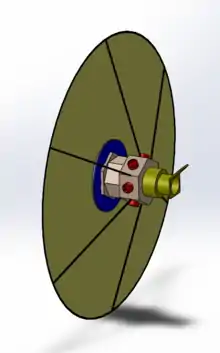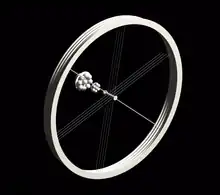Initiative for Interstellar Studies
The Initiative for Interstellar Studies (i4is) is a UK-registered not-for-profit company, whose objectives are education and research into the challenges of Interstellar Travel.[1] It pioneered small-scale laser sail interstellar probes (Project Dragonfly) and missions to interstellar objects (Project Lyra). Several of its principals were involved in the 100 Year Starship winning team originated by NASA and DARPA.[2]
| Abbreviation | i4is |
|---|---|
| Formation | 2012 |
| Founders | Kelvin F. Long, Rob Swinney |
| Legal status | Incorporated in the UK as a not-for-profit company limited by guarantee |
| Purpose | To conduct activities or research relating to the challenges of achieving robotic and human interstellar flight. |
| Location | |
Region served | World |
Membership | Astronautical engineers Astrophysicists |
Executive Director | Andreas M. Hein |
Main organ | Principium |
| Website | www.i4is.org |
| Remarks | See also the i4is blog |
The US activities of i4is are coordinated by the Institute for Interstellar Studies, a not-for-profit registered in Tennessee, USA.
Notable projects and activities

i4is has initiated a project working on small interstellar spacecraft, propelled by a laser sail in 2013 under the name of Project Dragonfly.[3][4] Four student teams worked on concepts for such a mission in 2014 and 2015 in the context of a design competition.[5][6][7][8][9] The design of the team from the University of California, Santa Barbara, has subsequently been selected as the baseline system architecture for Breakthrough Starshot. A subsequent study, Project Andromeda, has provided input to Breakthrough Starshot prior to its announcement in 2016.[10][11][12]
Project Lyra: In November 2017, i4is launched Project Lyra and proposed a set of mission concepts for reaching the interstellar objects 1I/ʻOumuamua, 2I/Borisov, and yet to be discovered objects.[13][14][15][16] The project has been featured in numerous media outlets.[17][18][19][20][21][22]
World Ships:

i4is has published on world ships, large interstellar generation ships and has presented its results at the ESA Interstellar Workshop in 2019 as well as in ESA's Acta Futura journal.[24][25][26] Several of its core team members have previously worked on Icarus Interstellar's Project Hyperion.
Venus astrobiology mission: Subsequent to the alleged discovery of phosphine in the Venusian atmosphere in 2020, i4is published a study on a dedicated astrobiology mission, based on a fleet of balloons to probe the Venusian atmosphere.[27][28]
Principium: The i4is publishes a quarterly newsletter, Principium.[29]
Prominent figures
The i4is has a number of internationally renowned academics and engineers who have oversight and involvement with its work -
- Freeman Dyson FRS, theoretical physicist and mathematician, professor emeritus Institute for Advanced Study was a member of the Advisory Council of the i4is
- Alan Bond, Managing Director of Reaction Engines Limited, is a consultant to i4is.
- Dr Ian Crawford, Professor of Planetary Science and Astrobiology at the Department of Earth and Planetary Sciences, Birkbeck College, University of London[30] is a member of the Advisory Council of the i4is
- Gregory L. Matloff, professor New York City College of Technology[31] is Chair of the Advisory Council of the i4is.[32]
References
- “The Institute for Interstellar Studies”, Spaceflight (magazine), Editorial, Vol.54, No.12, p.445, December 2012, by David Baker
- "100 Year Starship". DARPA. Archived from the original on 2013-07-22.
- “Project Dragonfly”, i4is.org/news/dragonfly
- "Project Dragonfly: The case for small, laser-propelled, distributed probes".
- Perakis, Nikolaos; Schrenk, Lukas; Gutsmiedl, Johannes; Koop, Artur; Losekamm, Martin J (2016). "Project Dragonfly: A feasibility study of interstellar travel using laser-powered light sail propulsion". Acta Astronautica. 129: 316–324. Bibcode:2016AcAau.129..316P. doi:10.1016/j.actaastro.2016.09.030.
- Häfner, Tobias; Kushwaha, Manisha; Celik, Onur; Bellizzi, Filippo (2019). "Project Dragonfly: Sail to the stars". Acta Astronautica. 154: 311–319. Bibcode:2019AcAau.154..311H. doi:10.1016/j.actaastro.2018.05.018. S2CID 116056664.
- "Project Dragonfly - Sail to the Stars".
- "Project Dragonfly: Design Competitions and Crowdfunding".
- Cain, Fraser. "Project Dragonfly. A Laser-Powered Probe to Alpha Centauri". Universe Today. Retrieved 14 February 2021.
- Moody, Oliver. "Tiny armada to explore space". The Times. Retrieved 15 February 2021.
- Emerging Technology from the arXiv. "Femto-Spacecraft Could Travel to Alpha Centauri". MIT Technology Review. Retrieved 14 February 2021.
- Hein, Andreas M; Long, Kelvin F; Fries, Dan; Perakis, Nikolaos; Genovese, Angelo; Zeidler, Stefan; Langer, Martin; Osborne, Richard; Swinney, Rob; Davies, John (2017). "The Andromeda Study: A Femto-Spacecraft Mission to Alpha Centauri". arXiv:1708.03556 [astro-ph.IM].
- Hein, Andreas M.; Perakis, Nikolaos; Eubanks, T. Marshall; Hibberd, Adam; Crowl, Adam; Hayward, Kieran; Kennedy III, Robert G.; Osborne, Richard (7 January 2019). "Project Lyra: Sending a spacecraft to 1I/'Oumuamua (former A/2017 U1), the interstellar asteroid". Acta Astronautica. 161: 552–561. arXiv:1711.03155. Bibcode:2017arXiv171103155H. doi:10.1016/j.actaastro.2018.12.042. S2CID 119474144.
- Hibberd, Adam; Perakis, Nikolaos; Hein, Andreas M. (13 September 2019). "Sending a Spacecraft to Interstellar Comet C/2019 Q4 (Borisov)". Earth and Planetary Astrophysics. arXiv:1909.06348.
- Hibberd, Adam; Hein, Andreas M (2021). "Project Lyra: Catching 1I/'Oumuamua-Using Nuclear Thermal Rockets". Acta Astronautica. 179: 594–603. arXiv:2008.05435. Bibcode:2021AcAau.179..594H. doi:10.1016/j.actaastro.2020.11.038. S2CID 221104007.
- Hibberd, Adam; Hein, Andreas M; Eubanks, T Marshall (2020). "Project Lyra: Catching 1I/'Oumuamua--Mission Opportunities After 2024". Acta Astronautica. 170: 136–144. arXiv:1902.04935. Bibcode:2020AcAau.170..136H. doi:10.1016/j.actaastro.2020.01.018. S2CID 119078436.
- Powell, Corey S. "Visitors from deep space are buzzing our solar system. The race is on to explore them". NBC News. Retrieved 14 February 2021.
- Greshko, Michael (4 October 2019). "Interstellar comet starts coming into focus". National Geographic. Retrieved 14 February 2021.
- Oberhaus, Daniel. "Should Earthlings Chase 'Oumuamua Into Interstellar Space?". Wired. Retrieved 14 February 2021.
- Powell, Corey S. "What is Oumuamua? Here's what we know about the interstellar object". NBC News. Retrieved 14 February 2021.
- Williams, Matt. "Could we intercept interstellar comet C/2019 Q4 Borisov?". Phys.org. Retrieved 14 February 2021.
- Ciaccia, Chris (20 September 2019). "Newly discovered interstellar visitor could be intercepted, study says". Fox News. Retrieved 14 February 2021.
- Hein, Andreas M.; Pak, Mikhail; Pütz, Daniel; Bühler, Christian; Reiss, Philipp (2012). "World ships—architectures & feasibility revisited". Journal of the British Interplanetary Society. 65 (4): 119.
- Hein, Andreas M; Smith, Cameron; Marin, Frederic; Staats, Kai (2020). "World Ships: Feasibility and Rationale". Acta Futura. 12: 75–104. arXiv:2005.04100. doi:10.5281/zenodo.3747333. S2CID 218571111.
- Faife, Corin (17 December 2019). "Scientists Are Contemplating a 1,000-Year Space Mission to Save Humanity". Medium - OneZero. Retrieved 14 February 2021.
- Hein, Andreas M; Smith, Cameron; Marin, Frédéric; Staats, Kai. "World Ships –Feasibility and Rationale" (PDF). Retrieved 16 February 2021.
- Dorminey, Bruce. "Proposed Venus Balloon Mission Could Detect Life By 2022". Forbes. Retrieved 14 February 2021.
- Hein, Andreas M; Lingam, Manasvi; Eubanks, T Marshall; Hibberd, Adam; Fries, Dan; Blase, William Paul (2020). "A Precursor Balloon Mission for Venusian Astrobiology". The Astrophysical Journal Letters. 903 (2): L36. arXiv:2009.11826. Bibcode:2020ApJ...903L..36H. doi:10.3847/2041-8213/abc347. S2CID 221878878.
- "Principium". i4is.
- "Dr Ian Crawford". Birkbeck College, University of London.
- "Gregory L. Matloff". New York City College of Technology. Archived from the original on 2012-10-19. Retrieved 2013-07-19.
- "I4IS - Senior Advisory Council". www.i4is.org. Archived from the original on 18 September 2012. Retrieved 15 May 2022.